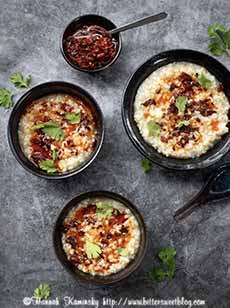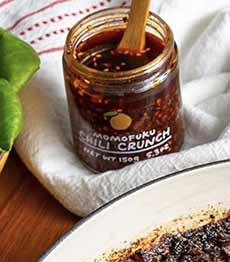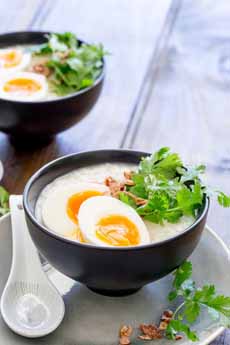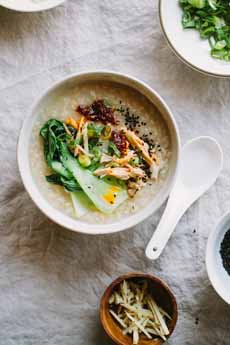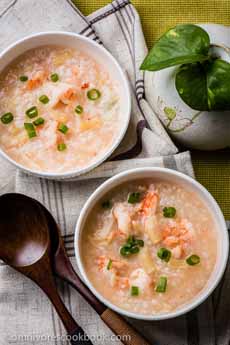Hot & Spicy Congee Recipe For International Hot & Spicy Day
|
|
Have you ever eaten something that was spicy enough to wake the dead? Then try the Hot & Spicy Congee recipe below. O.K., maybe waking the dead is an exaggeration. But though not for the weak of stomach, this recipe works for cold or flu season, and might be just what the doctor ordered: a hot and spicy alterative to Jewish chicken soup. Just in time for International Hot & Spicy Day, January 16th, our colleague Hannah Kaminsky of Bittersweet Blog turned creamy, hearty, and soothing, classic congee (Chinese rice porridge) into something befitting the holiday. The dish gets a spicy upgrade with a generous spoonful of chili crisp (a.k.a. chili crunch), an ingredient that’s been “discovered” in the U.S. over the past few years. This easy-to-make dish is something spicy for breakfast, a side dish with flair, or as a main course like risotto, topped with shrimp, tofu, or other protein—even beans. Toppings for congee are entirely up to the eater. Like risotto, the creamy rice porridge is, as Hannah says, “a gracious base for anything your heart desires.” She’s a big fan of shiitake mushrooms paired with congee. “Add textural contrast,” she says, “with toasted pine nuts or slivered almonds.” But the chili crunch, she advises, is “what transforms a bowl of mush into a downright addictive meal,” which she can eat straight from the jar. And by the way, this spicy congee recipe is also helper when you’re feeling under the weather. Read more below. > The history of congee is also below. Chili crisp, also known as chili crunch, is a Chinese condiment that consists of fried garlic, onions, shallots, and chili flakes in oil. It was first made by Lao Gan Ma, a Chinese food company known for its chili sauce products. The exact origin of chili crisp is a crisp tale as well. Back in 1989, Lao Gan Ma’s founder, Tao Huabi, was an illiterate widow raising two sons in a rural village in Guizhou Province, one of the poorest regions in China’s southwest. She ran a food truck and sold tofu cold noodles. She offered her homemade chile sauces for dipping. Before long, she noticed that customers preferred her chile sauces over her tofu and noodles. And so, in 1996, the Lao Gan Ma brand was born. The name means old godmother. More than two decades later, Tao has a reported net worth of $1.9 billion, making her one of the richest women in China. Here’s more about it. Total prep and cook time is 1 hour. 1. COMBINE the rice, stock, salt, ginger garlic, and soy sauce in a medium saucepan. Bring the mixture to a boil, then reduce the heat to a low simmer. Stir occasionally so that the rice doesn’t clump or stick to the bottom. 2. SIMMER for about 1 hour, or until the rice is fully cooked and the congee is thick and creamy. Ladle into bowls and top with chili crisp and cilantro, as desired. Enjoy hot. The congee will continue to thicken as it cools. Adjust with additional stock or water if needed to achieve your desired consistency. Congee, rice porridge, has a long history and is a staple food in many Asian countries. The dish has its roots in China and has been consumed for millennia. Congee traces its origins back to ancient China, where it was considered a nutritious and easily digestible food. The earliest records of congee consumption date back to the Zhou Dynasty (1046–256 B.V.E.). It was initially used as a medicinal food to treat digestive ailments. It is also mentioned in the Chinese Record of Rites of the first century C.E., and noted in Pliny’s account of India circa 77 C.E. Over time, congee spread to other Asian countries, including Japan, Korea, Vietnam, and Thailand. Each region developed its own variations of the dish, incorporating local ingredients and flavors. For example: |
|
|
While the dish is associated with East Asian cuisine, the word “congee” itself has its origins in the Tamil kanji (also the Telugu and Kannada gañji, the Malayalan kanni and the Urdu ganji), from kanjī, “boilings,” referring to the water in which rice has been cooked [source]. Medicinal Uses Of Congee Congee was and is often prescribed by traditional Chinese medicine practitioners for its healing properties. The soft porridge is easy on the digestive system and recommended for people recovering from illnesses. Thus, it’s not only a common breakfast dish and comfort food, but is also consumed during times of discomfort. Congee continues to evolve from its deep historical roots. Modern variations include sweet congees, with ingredients like red beans or fruit. Whatever the topping, congee remains a versatile and beloved dish, appreciated for its simplicity and adaptability, across Asia and beyond. Hot chile peppers have genuine medicinal properties thanks to their characteristic burn from capsaicin, the compound responsible. Plus, capsaicin has antibacterial properties which are effective in fighting and preventing chronic sinus infections. CHECK OUT WHAT’S HAPPENING ON OUR HOME PAGE, THENIBBLE.COM. |
||
